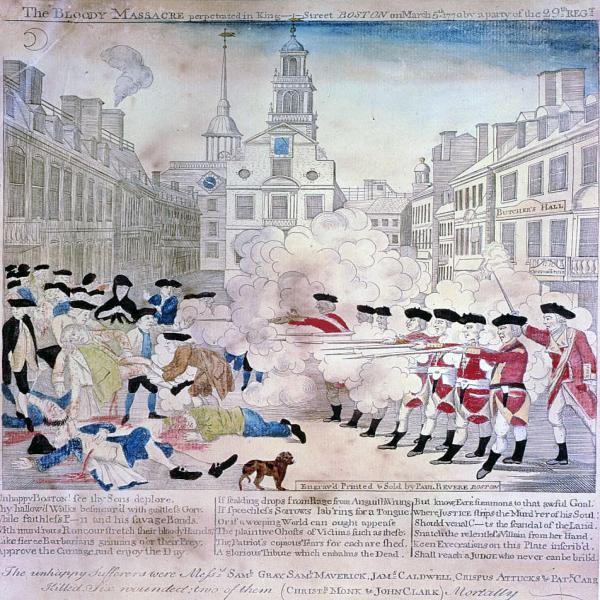Bloody Massacre Perpetuated in King Street by Revere
Original

Background Notes
Paul Revere (1734- 1818) was born and raised in Boston, learning the trade of silversmith from his father. He also took up dentistry and the profitable business of engraving for which he became well known. He, himself, was not an artist, though he became adept at engraving the designs of others. He is probably best remembered for his involvement in warning the colonists in Lexington and Concord that the British had landed and were marching towards Lexington. (1)
The Bloody Massacre, often referred to as “The Boston Massacre,” is an engraving by Paul Revere that was hand colored by Christian Remick (1725-after 1783), who was a mariner and artist that hand colored several of Revere’s prints. (2) This print is misleading because it inaccurately depicts British soldiers firing on their commander’s orders at a group of people in Boston. It also does not show Crispus Attucks, a mulatto, who was the first to die during the fight. (3) Despite its inaccuracies, it is Revere’s most well known print, and the most referenced print of the event. However, it is not the first print of the event. Allegedly, Revere copied his print from another by Peter Pelham. The two prints are nearly identical.
Crispus Attucks (ca. 1723-1770) was the first casualty of the American Revolution. On the evening of March 5, 1770, a confrontation between soldiers and a group of townspeople resulted in five dead and six wounded. Attucks, of African and Native American descent, grew up in Framingham, Massachusetts, and was said to be a runaway slave who found work and spent many years as a sailor and rope maker in Boston. He, along with other local sailors and rope makers, felt particularly threatened by British soldiers and sailors who would often compete for part-time jobs with the locals during off-duty hours. This competition lead to a fight on March 2, 1770, between British soldiers and local rope makers, which helped fuel tensions that lead to the massacre a few days later. (4) Colonists, in general, were very agitated with the increased taxes put on them by the British government, as well as the increased presence of British troops in town. Tensions between the colonists and the British troops built to a point that made confrontation inevitable. (5)
The confrontation on March 5, 1770 that became known as the Boston Massacre, began when a large group of locals started taunting British soldiers with snowballs, stones, and clubs. At the head of this group was Attucks. Several British soldiers came to the rescue of the soldiers being taunted and open fired on the crowd. It is unclear whether Attucks attacked a soldier first, but he ended up being the first fatality from bullet wounds. Two others, Samuel Gray and James Caldwell, also died during the incident. Two others, Samuel Maverick and Patrick Carr died days later as a result of their injuries. Six others were wounded. (6)
(1) Garraty, John A. and Mark C. Carnes, American National Biography, Vol. 18 (New York: Oxford University Press, 1999), 369-371
(2) Brigham, Clarence S. Paul Revere’s Engravings (New York: Atheneum, 1969), 61-63.
(3) Garraty, 369-371.
(4) http://www.pbs.org/wgbh/aia/part2/2p24.html